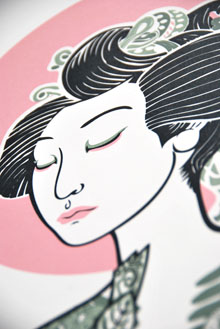 Al Gray is an artist based in Hertfordshire, England. His work draws inspiration from both the modern world of contemporary art and the historical world of traditional arts and crafts.
Al Gray is an artist based in Hertfordshire, England. His work draws inspiration from both the modern world of contemporary art and the historical world of traditional arts and crafts.
Having studied Illustration at Bristol UWE, Gray graduated with a BA (Hons) in 1996. For the next decade he worked as an illustrator, producing designs for some of the best-known names in editorial and corporate sectors such as Guinness, Loaded, The Ministry of Sound, Men's Health, Esquire, GQ (USA), The Telegraph, Independent and Guardian newspapers. As well as drawing for more underground publications like Lo down, Fatboss, Pil, Ape-man, and 7.
It was at this time Gray honed his skills as an image-maker. Much of this modern urban feel still remains in his work today as an artist.
Gray's parents' complimentary careers in antique dealing and picture restoration stretched the canvas for his interest in traditional arts and crafts. Gray was trained from an early age to recognise and restore all manner of antique pictures and gilded frames. It was through this schooling that the artist mastered the techniques of employing gold leaf and gesso commonly used in religious icons, as well as the traditional methods used in oil painting; both of which he uses in his current work.
Over the past five years Gray has developed his art practice to fuse these two worlds of contemporary urban design and traditional arts & craft, leading to some small solo and group exhibitions in the UK.
In 2010 Gray produced his "Tattoo" series, a collection of 12 limited editions and artist proof prints which made its debut exhibition in the artist's hometown Hertford. Focusing on traditional Japanese art, particularly wood block prints, Gray was inspired by their elaborate use of line and intense detail. The collection's prevalent theme of Japanese tattoos allows Gray to paint worlds within the figures that inhabit his work. It is a way of describing a hidden inner realm; elaborate and precise, dark and sublime.
Gray's coexisting interest in antique paintings and craft, in particular Divine iconic panels, has merged with this series to create his current practice. The artist uses the same traditional methods used for centuries to create his icons. However, Gray's panels seem to construct a new symbolism where the figures unveil their own concealed world to the viewer, rather than being subject to a realm impressed upon them. Grays saints, isolated in a golden aura, invite us to know them and feast on that knowledge in all its intricacy and detail.
